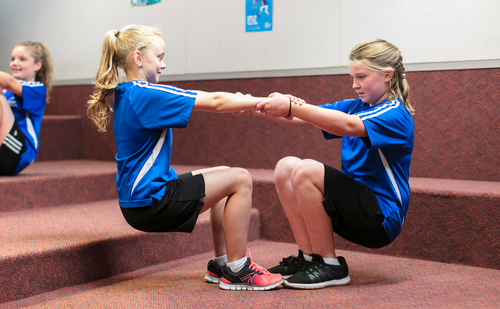Ask tamariki to pair up with someone who’s about the same height.
They will need to:
- Sit facing each other.
- Have their feet out in front, heels on the floor but the soles of their footwear touching (they will need to be wearing shoes!)
- Ask tamariki to wriggle closer to each other so their knees are now bent.
- Ask tamraiki to reach out towards each other and either hold hands, or grip each others’ forearms.
- Then stand up!

Let them work at this – it can be quite tricky despite seeming simple.
If after a few minutes they’re still struggling let them know that they’ll need to use each other’s feet as a firm base to push against, and lean away from each other (which seems counter-intuitive) using their weight to help pull them up. It's about 'balance'.
If some pairs succeed, ask them to try again until they feel really accomplished, or you may like to ask them to kindly coach others who are finding this exercise more challenging.
After about 10 minutes ask tamariki to freeze and debrief asking:
- What’s challenging about this?
- What’s helping you work it out? (Even if they haven’t yet).
- Do you notice if you’re a leader, or are you following instructions? Or both? Both are equally important!
- What strengths are you using in these roles?
- If you haven’t managed to stand up together YET (!), what would you say to others who are in the same situation to encourage them? Apply this to yourselves!
Ask tamariki to continue trying to get up, coaching each other and thinking about what strengths they can call upon to help.
If your class particularly love the challenge, they can then join as fours to see if this works (as a circle). Ask others to join – try 8. (NB: Physics will dictate that tamarki won’t be able to make this work beyond 8-10 people.)
When you feel the class is ready to move on, ask them to return to their pairs and:
- Sit on the floor back-to-back.
- Link their arms and work together to stand up (without un-linking their arms!)
This activity is more challenging than the first. One trick is to lean into each other’s backs and push your feet hard into the floor.
You might need to mix up the pairs after a time, to allow different tamariki to try together.
If pairs manage this activity, ask them to stand back-to-back, link their arms, and sit down together. Let them try it themselves, and if they struggle, mention that they’ll need to start by slowly walking their feet out, then lower into a squat position, while leaning against each other (i.e. the reverse of what they just did).
Ask these pairs to coach others in the room who are finding the activity challenging.
After about 5 – 10 minutes, ask tamariki to freeze and debrief by asking:
- Are you the leader this time, or following instructions more?
- What strengths are you drawing upon for this?
- What would you need to do differently if you had to take the other role (leading / following)?
- Can you see that you learn as much from this activity by NOT getting up, as you actually do by getting up? The activity is not all about ‘succeeding’. It’s about trust, working together, and learning about yourself.
- What can you take away from this exercise and use in other things you do?

You can revisit this exercise anytime so tamariki have an opportunity to work with others, practice and join the larger mega-groups.


